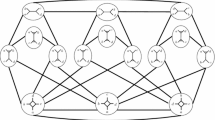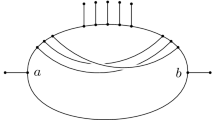Abstract
In phylogenetics, a common strategy used to construct an evolutionary tree for a set of species \(X\) is to search in the space of all such trees for one that optimizes some given score function (such as the minimum evolution, parsimony or likelihood score). As this can be computationally intensive, it was recently proposed to restrict such searches to the set of all those trees that are compatible with some circular ordering of the set \(X\). To inform the design of efficient algorithms to perform such searches, it is therefore of interest to find bounds for the number of trees compatible with a fixed ordering in the neighborhood of a tree that is determined by certain tree operations commonly used to search for trees: the nearest neighbor interchange (nni), the subtree prune and regraft (spr) and the tree bisection and reconnection (tbr) operations. We show that the size of such a neighborhood of a binary tree associated with the nni operation is independent of the tree’s topology, but that this is not the case for the spr and tbr operations. We also give tight upper and lower bounds for the size of the neighborhood of a binary tree for the spr and tbr operations and characterize those trees for which these bounds are attained.







Similar content being viewed by others
References
Allen B, Steel M (2001) Subtree transfer operations and their induced metrics on evolutionary trees. Ann Comb 5:1–15
Bansal MS, Eulenstein O (2008) An \(\omega \) (n \(\hat{}\)2/log n) speed-up of tbr heuristics for the gene-duplication problem. IEEE/ACM Trans Comput Biol Bioinform (TCBB) 5(4):514–524
Bastkowski S, Spillner A, Moulton V (2014) Fishing for minimum evolution trees with Neighbor-Nets. Inf Process Lett 114:13–18
Bryant D (1996) Hunting for trees in binary character sets: efficient algorithms for extraction, enumeration and optimization. J Comput Biol 3:275–288
Bryant D (1997) Building trees, hunting for trees and comparing trees. PhD thesis, University of Canterbury, NZ
Bryant D (2004) The splits in the neighborhood of a tree. Ann Comb 8:1–11
Bryant D, Moulton V (2004) Neighbor-net: an agglomerative method for the construction of phylogenetic networks. Mol Biol Evol 21:255–265
Cleary S, St John K (2009) Rotation distance is fixed-parameter tractable. Inf Process Lett 109:918–922
De Loera J, Rambau J, Santos F (2010) Triangulations: structures for algorithms and applications, algorithms and computation in mathematics, vol 25. Springer, Berlin
Desper R, Gascuel O (2002) Fast and accurate phylogeny reconstruction algorithms based on the minimum-evolution principle. J Comput Biol 9:687–705
Ding Y, Grunewald S, Humphries P (2011) On agreement forests. J Comb Theory Ser A 118:2059–2065
Felsenstein J (2004) Inferring phylogenies. Sinauer Associates Inc, Sunderland
Gordon K, Ford E, St John K (2013) Hamiltonian walks of phylogenetic treespaces. IEEE/ACM Trans Comput Biol Bioinform (TCBB) 10(4):1076–1079
Humphries P, Wu T (2013) On the neighborhoods of trees. IEEE/ACM Trans Comput Biol Bioinform 10:721–728
Jamison R (1987) Alternating whitney sums and matchings in trees. Discret Math 67:177–189
Kubatko L (2008) Inference of phylogenetic trees. In: Friedman A (ed) Tutorials in mathematical biosciences IV: evolution and ecology, Lecture notes in mathematics, vol 1922. Springer, Berlin, pp 1–38
Lemey P, Salemi M, Vandamme AM (2009) The phylogenetic handbook: a practical approach to phylogenetic analysis and hypothesis testing. Cambridge University Press, Cambridge
Li M, Tromp J, Zhang L (1996) On the nearest neighbor interchange distance between evolutionary trees. J Theor Biol 182:463–467
Luccio F, Enriquez AM, Pagli L (2010) Lower bounds on the rotation distance of binary trees. Inf Process Lett 110(21):934–938
Pournin L (2014) The diameter of associahedra. Adv Math 259:13–42
Robinson D (1971) Comparison of labeled trees with valency three. J Comb Theory Ser B 11:105–119
Robinson D, Foulds L (1981) Comparison of phylogenetic trees. Math Biosci 53:131–147
Sanderson MJ, McMahon MM, Steel M (2011) Terraces in phylogenetic tree space. Science 333(6041):448–450
Semple C, Steel M (2003) Phylogenetics. Oxford University Press, Oxford
Semple C, Steel M (2004) Cyclic permutations and evolutionary trees. Adv Appl Math 32:669–680
Sleator D, Tarjan R, Thurston W (1988) Rotation distance, triangulations and hyperbolic geometry. J Am Math Soc 1:647–681
Tepe E, Farruggia F, Bohs L (2011) A 10-gene phylogeny of Solanum section Herpystichum (Solanaceae) and a comparison of phylogenetic methods. Am J Bot 98:1356–1365
Whelan S, Money D (2010) The prevalence of multifurcations in tree-space and their implications for tree-search. Mol Biol Evol 27:2674–2677
Acknowledgments
Parts of the results presented here were included in the PhD dissertation of Sarah Baskowski, University of East Anglia, 2014. We also thank two anonymous referees for their constructive suggestions.
Author information
Authors and Affiliations
Corresponding authors
Rights and permissions
About this article
Cite this article
Baskowski, S., Moulton, V., Spillner, A. et al. Neighborhoods of Trees in Circular Orderings. Bull Math Biol 77, 46–70 (2015). https://doi.org/10.1007/s11538-014-0049-1
Received:
Accepted:
Published:
Issue Date:
DOI: https://doi.org/10.1007/s11538-014-0049-1






